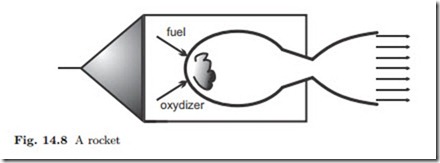Rockets, Ramjet and Scramjet
Jet engines are air-breathing, that is they carry the fuel on board, and burn it with oxygen from the ambient air that passes through the engine. Rockets carry the oxygen on board, either as liquefied oxygen, or in the form of a compound. Thus, rockets are independent of ambient air, and can fly at extremely high altitude, and in space. In a rocket motor, fuel and oxidizer are burnt at high pressure in the combustion chamber and then expand through a Laval nozzle, which provides large supersonic exit velocities, and thus large thrust, see Fig. 14.8.
The oxygen a rocket has to carry on board increases the take-off weight, and reduces the payload that can be carried along. Some military applications require fast transport of payload through the atmosphere,3 and rockets are used because they offer extremely high velocities.
Ramjet and scramjet are conceptually simple air-breathing engines for supersonic flight, hence they do not require to carry the heavy oxidizer on board.
In both pressure build-up in the engine is affected only through diffusers, see Fig. 14.9 for sketches.
In a ramjet, the incoming air is slowed down to subsonic speed and high pressure by means of a converging-diverging diffuser, which operates on the same principles as a Laval nozzle, only inversely. Fuel is injected into the com- pressed air and burned, the hot combustion product then expands through a Laval nozzle to high velocities. Ramjets can be used for supersonic flight with speeds up to Ma = 6.
In a scramjet (supersonic combustion ramjet), the flow stays supersonic at all times. A supersonic diffuser slows down the flow and pressure increases.
Fuel is injected into the flow and burned, and the hot pressurized combustion product leaves through a supersonic nozzle. Flight speeds could be up to Ma = 15 or so. Due to the high air velocity at the burner, it is quite difficult to maintain stable combustion of the fuel. To get the scramjet engine started it must be accelerated to supersonic speed first, so that the converging diffuser leads to pressure build-up.

